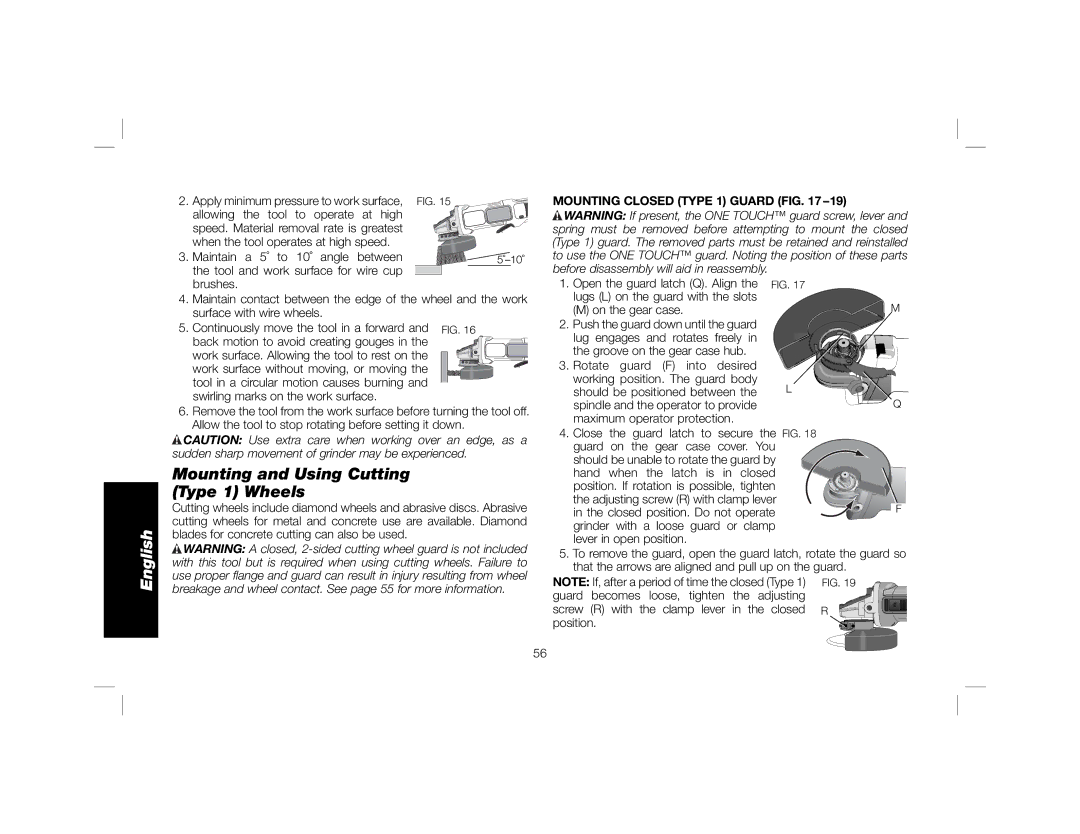
English
2. | Apply minimum pressure to work surface, | FIG. 15 |
| allowing the tool to operate at high |
|
| speed. Material removal rate is greatest |
|
| when the tool operates at high speed. |
|
3. | Maintain a 5˚ to 10˚ angle between | |
| the tool and work surface for wire cup |
|
brushes.
4.Maintain contact between the edge of the wheel and the work surface with wire wheels.
5. Continuously move the tool in a forward and FIG. 16
back motion to avoid creating gouges in the work surface. Allowing the tool to rest on the work surface without moving, or moving the tool in a circular motion causes burning and
swirling marks on the work surface.
6.Remove the tool from the work surface before turning the tool off. Allow the tool to stop rotating before setting it down.
![]() CAUTION: Use extra care when working over an edge, as a sudden sharp movement of grinder may be experienced.
CAUTION: Use extra care when working over an edge, as a sudden sharp movement of grinder may be experienced.
Mounting and Using Cutting
(Type 1) Wheels
Cutting wheels include diamond wheels and abrasive discs. Abrasive cutting wheels for metal and concrete use are available. Diamond blades for concrete cutting can also be used.
![]() WARNING: A closed,
WARNING: A closed,
56
MOUNTING CLOSED (TYPE 1) GUARD (FIG. 17 –19)
![]() WARNING: If present, the ONE TOUCH™ guard screw, lever and spring must be removed before attempting to mount the closed (Type 1) guard. The removed parts must be retained and reinstalled to use the ONE TOUCH™ guard. Noting the position of these parts
WARNING: If present, the ONE TOUCH™ guard screw, lever and spring must be removed before attempting to mount the closed (Type 1) guard. The removed parts must be retained and reinstalled to use the ONE TOUCH™ guard. Noting the position of these parts
before disassembly will aid in reassembly. |
|
|
| |
1. | Open the guard latch (Q). Align the | FIG. 17 | ||
| lugs (L) on the guard with the slots |
| M | |
| (M) on the gear case. |
| ||
2. | Push the guard down until the guard |
|
|
|
| lug engages and rotates freely in |
|
|
|
|
|
|
| |
| the groove on the gear case hub. |
|
|
|
3. | Rotate guard (F) into desired |
|
|
|
| working position. The guard body | L | ||
| should be positioned between the | |||
| spindle and the operator to provide |
| Q | |
| maximum operator protection. |
|
|
|
4.Close the guard latch to secure the FIG. 18 guard on the gear case cover. You should be unable to rotate the guard by
hand when the latch is in closed |
|
position. If rotation is possible, tighten |
|
the adjusting screw (R) with clamp lever | F |
in the closed position. Do not operate | |
grinder with a loose guard or clamp |
|
lever in open position. |
|
5.To remove the guard, open the guard latch, rotate the guard so that the arrows are aligned and pull up on the guard.
NOTE: If, after a period of time the closed (Type 1) guard becomes loose, tighten the adjusting screw (R) with the clamp lever in the closed position.
